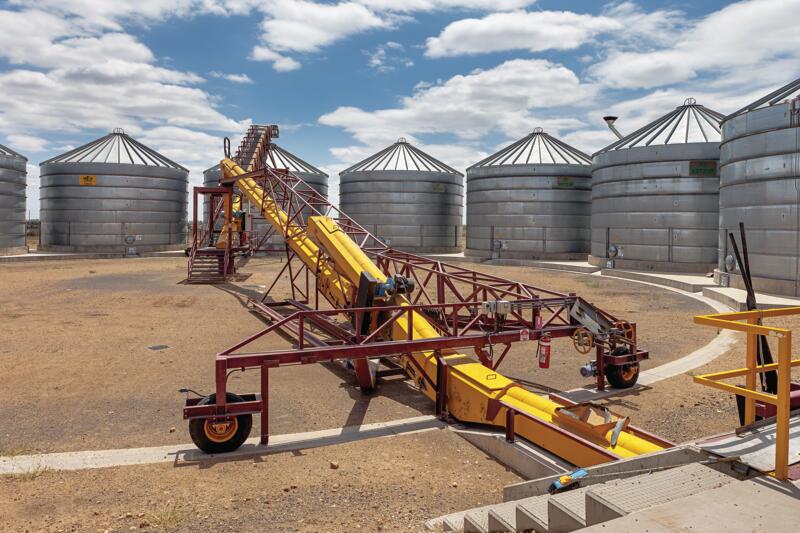RIGHT now, grain production in Australia is a guessing game. The east coast is deep in drought and in Western Australia there’s a surplus of grain, but nobody really knows how much stock is in the country because the grains industry doesn’t release accurate stocks information.
A lot of questions are asked and a lot of guestimates are made. Do we have adequate stocks within the NSW east coast, on-farm or in the bulk handling system? Do we need to import grain from overseas or from the west coast of Australia? The truth is nobody knows for sure.
Agencies such as the Australian Bureau of Agricultural and Resource Economics and Sciences (ABARES) offer estimates on grain stocks and bulk handlers have some idea of how much grain is available. Growers make monthly estimates based on growing conditions and other information, and private forecasters will also give opinions, but in the end it’s still a guessing game.
Grain production can change drastically and rapidly. A couple of years ago, the ABARES grain production forecast was more than three million tonnes out. In February 2017, it said the 2016-17 wheat crop was 35 million tonnes, then dropped it to 31.8 million tonnes a year later. That caused a sharp rise in crop prices as domestic end users scrambled to get hold of limited supplies. It begs the question, how did we get it so wrong?
 A large grain conveyer belt feeds wheat into silos at Moree, North West NSW. Source: Getty Images.
A large grain conveyer belt feeds wheat into silos at Moree, North West NSW. Source: Getty Images.
After that large variation everyone said well that was our best guess. If the crop wasn’t as big as the official estimate, was that stock still stored on-farm or was the demand underestimated?
“People can’t make good decisions based on bad information. We need accuracy rather than a hotchpotch of collected data. We need to make decisions based on the correct information, not a gut feeling.” – Matthew Madden
Real-time harvest information, such as weekly data on the crop as it comes in, would allow industry to profile the crop and decide what is high grade, feed or milling grades. Quarterly information on total stocks that are in the system as well as on-farm stocks need to be surveyed.
RELATED ARTICLES ON GRAIN FARMERS:
-
Drought-affected crop growers face tough decisions
-
The Riverina farmers big on soil conservation
-
What makes a truly innovative farmer?
-
From sheep to cropping
Accurate reporting of exports would mean knowing what’s leaving the country before it goes. Right now exports are counted six weeks post shipment. Before that nobody knows for sure.
Some people would like to play the market, but that’s not a sign of a mature industry. Better stocks disclosure would put bulk handlers, traders and producers all on the same page.
“Having a rigorous stocks reporting system in place would improve transparency, price discovery and public policy. It would level the playing field.” – Matthew Madden
There would be a clear sign that there isn’t a lot of a particular grade of wheat around, for example, and farmers could market supplies accordingly.
Nobody is exactly sure what stocks are available and nobody wants to get caught out trying to import grain at short notice. There are strict protocols in place that make it difficult to do this.
 NSW Farmers Grains Committee chair Matthew Madden. Photo by: Nick Cubbin.
NSW Farmers Grains Committee chair Matthew Madden. Photo by: Nick Cubbin.
Industry is moving toward a consensus but it’s still a work in progress and we’re not there yet. There are ongoing discussions about who would deliver the information and where this data would be kept.
Some argue that if all Australian grain farmers knew exactly what stocks there were, then our international competitors would also know, giving them an advantage. The truth is, overseas markets like the United States may already know more about what grains are produced in Australia than we do ourselves.
RELATED: Newcastle set to be export hub for farmers
In most countries it’s mandatory to report stocks. Transparent systems give them a very good idea of what they have produced, what they have exported and what their prices are.
We need to know for sure that we have the quantity and the quality of grain to ensure the business goes forward. If we’re not sure, some will be lining up to import more just in case. Importing grain from overseas could threaten our biosecurity regimes. If we know exactly what we have in Australia, then we don’t have to put our grains industry at risk.
**These are Matthew’s personal views. If you would like to be ‘On my soapbox’ in a future issue of The Farmer, email: [email protected] or write to: The Farmer, Suite 53/26-32 Pirrama Rd, Pyrmont, NSW 2009. If your topic is chosen, a journalist will be in touch.
Fast facts about the Australian grain industry
🌾As a member of
Grain Producers Australia, NSW Farmers has lobbied the federal government for several years to compel the grains industry to implement a system that allows for better reporting of stocks.
🌾Each year grains and horticulture bring $7.2 billion into NSW and ongoing research and innovations keep this figure growing.
🌾In 2016-17, the gross value of production of the NSW grains industry was $6.2 billion, including wheat, cotton, barley, pulses and oilseeds.
🌾Almost 30% of Australian farms produced grains between 2015-16, with wheat being the most important individual crop by tonnage and value.
🌾Total production of wheat in 2015-16 was about 22.3 million tonnes, 56% of total grains industry tonnage, compared to 31.8 million tonnes in 2016-17 (adjusted from the earlier official production forecast of 35 million tonnes).
Sources: NSW Farmers, Australian Bureau of Agricultural and Resource Economics and Sciences